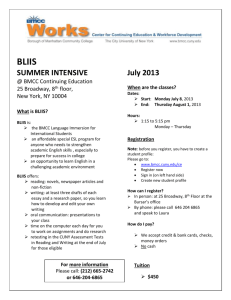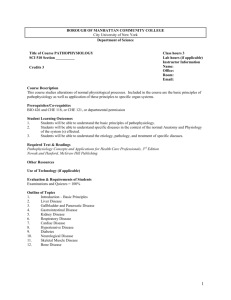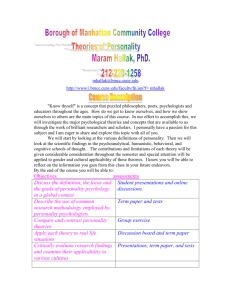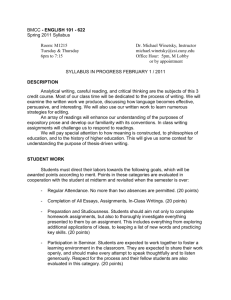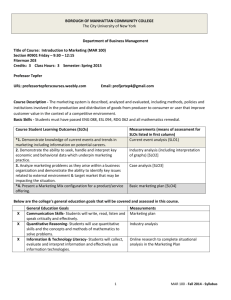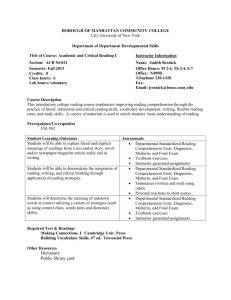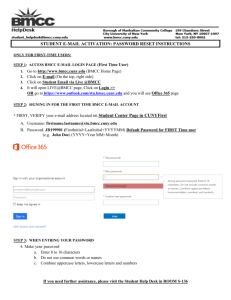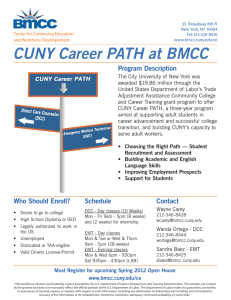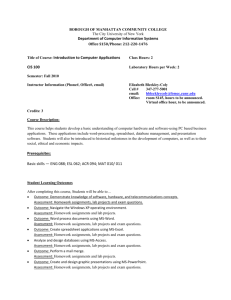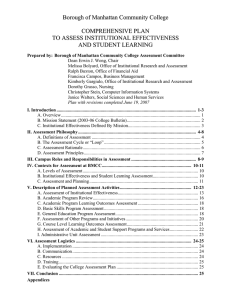Sample Syllabus
advertisement
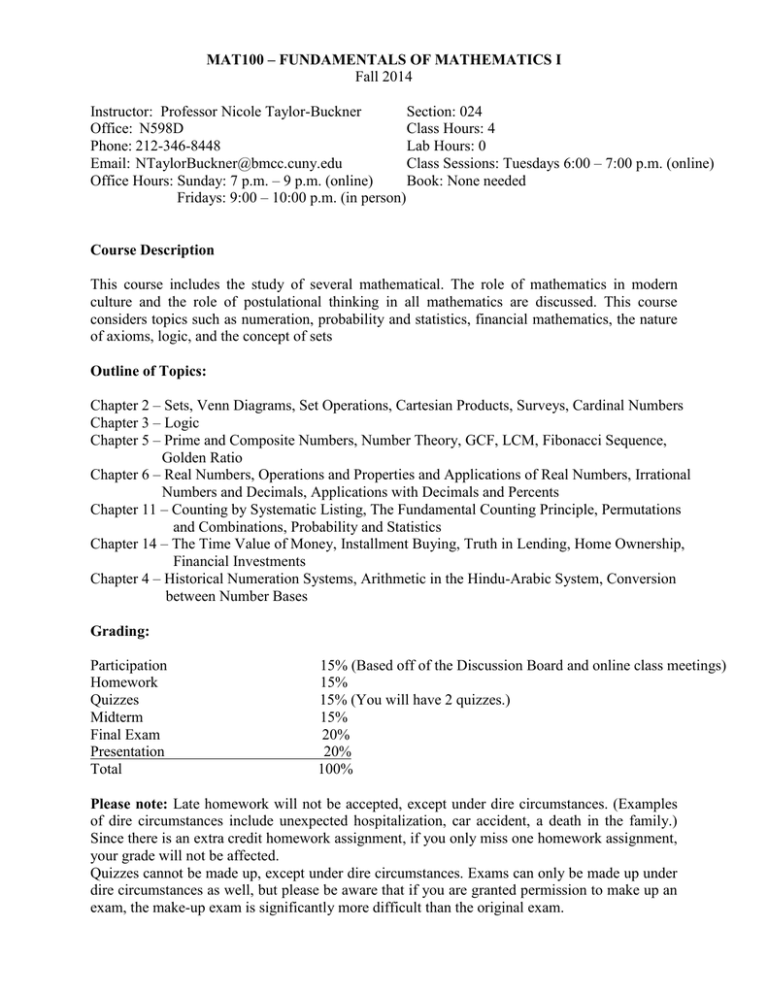
MAT100 – FUNDAMENTALS OF MATHEMATICS I Fall 2014 Instructor: Professor Nicole Taylor-Buckner Section: 024 Office: N598D Class Hours: 4 Phone: 212-346-8448 Lab Hours: 0 Email: NTaylorBuckner@bmcc.cuny.edu Class Sessions: Tuesdays 6:00 – 7:00 p.m. (online) Office Hours: Sunday: 7 p.m. – 9 p.m. (online) Book: None needed Fridays: 9:00 – 10:00 p.m. (in person) Course Description This course includes the study of several mathematical. The role of mathematics in modern culture and the role of postulational thinking in all mathematics are discussed. This course considers topics such as numeration, probability and statistics, financial mathematics, the nature of axioms, logic, and the concept of sets Outline of Topics: Chapter 2 – Sets, Venn Diagrams, Set Operations, Cartesian Products, Surveys, Cardinal Numbers Chapter 3 – Logic Chapter 5 – Prime and Composite Numbers, Number Theory, GCF, LCM, Fibonacci Sequence, Golden Ratio Chapter 6 – Real Numbers, Operations and Properties and Applications of Real Numbers, Irrational Numbers and Decimals, Applications with Decimals and Percents Chapter 11 – Counting by Systematic Listing, The Fundamental Counting Principle, Permutations and Combinations, Probability and Statistics Chapter 14 – The Time Value of Money, Installment Buying, Truth in Lending, Home Ownership, Financial Investments Chapter 4 – Historical Numeration Systems, Arithmetic in the Hindu-Arabic System, Conversion between Number Bases Grading: Participation Homework Quizzes Midterm Final Exam Presentation Total 15% (Based off of the Discussion Board and online class meetings) 15% 15% (You will have 2 quizzes.) 15% 20% 20% 100% Please note: Late homework will not be accepted, except under dire circumstances. (Examples of dire circumstances include unexpected hospitalization, car accident, a death in the family.) Since there is an extra credit homework assignment, if you only miss one homework assignment, your grade will not be affected. Quizzes cannot be made up, except under dire circumstances. Exams can only be made up under dire circumstances as well, but please be aware that if you are granted permission to make up an exam, the make-up exam is significantly more difficult than the original exam. Presentations The presentation can be on any topic we’ve covered in class, but it must extend the topic. Something new must be introduced in your presentation. For example, we’ve learned how to do the logic puzzles Sudoku and KenKen. Perhaps, you’d like to share with and teach the class another type of logic/mathematics puzzle. We’ve discussed the national debt, the federal budget, and budget deficits and surpluses. You may want to explore these topics further, or discuss another country’s economic situation. We’ve discussed interest, so you may want to present on different types of investments, etc. These are all examples of acceptable presentations. Presentations should be approximately ten minutes long (8 – 12 minutes), and if you include a video, the video should not take up more than 25% of your presentation. You can work with one other person, if you choose. In that instance, the presentation should be approximately 18 minutes long (16 – 20 minutes). If you decide to work with someone else, any issues you have, you will have to work out on your own. Once you decide on a topic, you will need to email me at ntaylorbuckner@bmcc.cuny.edu what your topic is by Saturday, November 22, 2014. The presentation is due to be posted in the Discussion Board Saturday, December 6, 2014. BMCC Policy on Plagiarism and Academic Integrity Statement Plagiarism is the presentation of someone else’s ideas, words or artistic, scientific or technical work as one’s own creation. Using the idea or work of another is permissible only when the original author is identified. Paraphrasing and summarizing, as well as direct quotations, require citations to the original source. Plagiarism may be intentional or unintentional. Lack of dishonest intent does not necessarily absolve a student of responsibility for plagiarism. Students who are unsure how and when to provide documentation are advised to consult with their instructors. The library has guides designed to help students to appropriately identify a cited work. The full policy can be found on BMCC’s website, www.bmcc.cuny.edu. For further information on integrity and behavior, please consult the college bulletin (also available online). Academic Adjustments/Students with Disabilities Students with disabilities who require reasonable accommodations or academic adjustments for this course must contact the Office of Services for Students with Disabilities. BMCC is committed to providing equal access to all programs and curricula to all students. Grading Scale: A 93 – 100% A- 90 – 92% B+ 87 – 89% B 83 – 86% BC+ C C- 80 – 82% 77 – 79% 73 – 77% 70 – 72% D+ D DF 67 – 69% 63 – 66% 60 – 62% Failure Student Learning Outcomes: 1) Students will learn the vocabulary, concepts and symbols of set theory, logic, historical numeration systems, modern number systems and its principles. 2) Students will be able to determine validity and the cardinality of a set and any of its subsets through the use of deductive reasoning and logic. 3) Students will be able to represent numerals from other places and other times giving a historical perspective of the numeration systems and they will be able to represent numbers in different bases and how to convert them from one base to another giving a modern and future view. 4) Students will be able to think critically about the structure of the real number system including operations and their properties, as well as the order and distribution of the rational and irrational numbers on the numerical real line. 5) Students will be able to use simple counting methods, including the Fundamental Counting Principle. 6) Students will be able to make financial mathematical calculations thus allowing them to make beneficial financial decisions. General Education Learning Outcomes 1. Communication Skills- Students will be able to write, read, listen, and speak critically and effectively. 2. Quantitative Reasoning- Students will be able to use quantitative skills and the concepts and methods of mathematics to solve problems. 3. Information & Technology Literacy- Students will be able to collect, evaluate, and interpret information and effectively use information technologies. Assessment Achievement of Learning Outcomes will be measured through homework, quizzes, participation in discussion boards, a midterm, a final examination, and a presentation.
